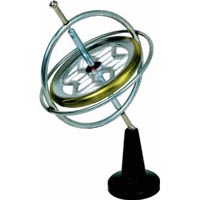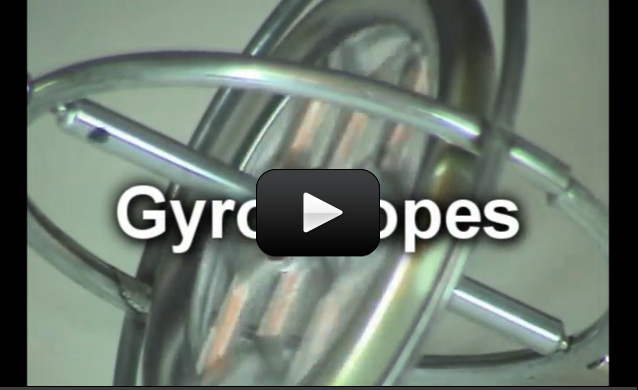 Gyroscopes defy human intuition, common sense, and even appear to defy gravity. You’ll find them in aircraft navigation instruments, games of Ultimate Frisbee, fast bicycles, street motorcycles, toy yo-yos, and the Hubble Space Telescope. And of course, the toy gyroscope (as shown here). Gyroscopes are used at the university level to demonstrate the principles of angular momentum, which is what we’re going to learn about here.
Gyroscopes defy human intuition, common sense, and even appear to defy gravity. You’ll find them in aircraft navigation instruments, games of Ultimate Frisbee, fast bicycles, street motorcycles, toy yo-yos, and the Hubble Space Telescope. And of course, the toy gyroscope (as shown here). Gyroscopes are used at the university level to demonstrate the principles of angular momentum, which is what we’re going to learn about here.
If you happen to have one of these toy gyroscopes, pull it out and play with it (although it’s not essential to this experiment). Notice that you can do all sorts of things with it when you spin it up, such as balance it on one finger (or even on a tight string). Wrap one end with string and hold the string vertically and you’ll find the gyro slowly rotates about the vertical string instead of flopping downward (as most objects do in Earth’s gravitational field). But why? Here’s the answer in plain English:
Please login or register to read the rest of this content.
Please login or register to read the rest of this content.


There are lots of sources for gyroscopes. Best thing is to do a search online.
Where can you get one of the smaller gyroscopes?
It’s funny you mention this, because I’ve looked for a replacement (it’s about 20 years old) and haven’t found one! I was thinking I could make one out of a rubbery-gel substance, but am not sure which I will try first.
You showed a gyroscope with a gel center that stretched. What was it called, and where could I get one? My grandson thought that was pretty cool.
Wanna know a fidget spinner trick? If you get one up to speed and try to tilt it, it will tilt the opposite direction in your hand in an attempt to stay vertical. (Warning: many fidget spinners contain lead and mercury which can kill you if you are around them a lot)
I wish I was there to see that! He must have looked hilarious!
He spun round because of gyro force
Yes, the faster the wheel spins, the more stable the axis is and the harder it becomes to move in a counter-direction. Not sure what you mean by a “sweet spot”…?
So, is the spinning ability of the bike wheel how bikers can do really cool spinning wheelies? Do they find the sweet spot and use it to spin?
That’s okay – science is like that. Try again!
it didnt work, the chair moved easily, and the wheel was spinning pretty fast. 🙁
Neither… the briefcase kept jerking him around – it looked so funny like he was pretending, but he really wasn’t.
Or did he spin? 🙂
Did his briefcase keep spinning around and around and around?!?! 😀
You can get them at toy stores!
Where can you get gyroscopes? I think they are pretty cool 🙂
Raena
age 10
It may… but make sure it’s spinning FAST and that your chair rotates freely (use the most low-friction chair you have – the kind that if you start spinning in it it’s hard to stop!)
It is not working for us. We are not able to make the chair turn. Would a bigger wheel work better?
i need to get out my tools and take off that wheel
I bet the boss was a bit FREAKED out!
Acceleration can be positive or negative, depending whether velocity is increasing or decreasing. Velocity has two components: speed and direction. When you have an object moving, you slap a coordinate system on top of it to figure out the velocity. For example: a car heading NW at 65 mph is a velocity. You know the speed (65 mph) and direction (NW). If North is the positive direction on the y-axis and East is the positive direction on the x-axis, then your velocity has x and y components and can be written as a vector.
For an object swinging in a circle (like a bike wheel), it is constantly changing direction (although the speed may be constant). A car traveling in circles will constantly be pointing its nose from N to NE to E to SE to S to SW to W to NW to S…etc. So the car is accelerating because the velocity, which can be either speed and direction (or both, like a car getting off the freeway).
The bike wheel case, the velocity is changing because the direction is changing, so the wheel is accelerating. The direction of the acceleration is in both the direction of the wheel’s motion (tangential acceleration = rotational acceleration x radius) and inward toward the hub (normal acceleration = rotation speed2 x radius).
If the wheel is also slowing down, then there’s another acceleration term involved. If the wheel has a lot of inertia (resistance to motion), then you have yet another factor to add in. And if you take a walk while it’s spinning, you have to account for your own walking (which includes yet another factor). Do you see how these start to get really complicated? That’s why there’s a full year of mechanics that college students take (called Statics and Dynamics) just to understand this stuff and get practice solving these types of problems. But you don’t need to worry – here’s what you really need to understand now:
Acceleration is negative if the change in velocity is negative, which can be either one of these: change in direction is negative on your coordinate system (which you specify when you’re doing the math part of the problem) or the speed is decreasing. Note that the acceleration could be positive for a negative velocity which is becoming less negative (e.g. speeding up).
By the way: Scientists and engineers tend to speak about “acceleration” as meaning a change in velocity, which can be either increasing or decreasing (decelerating) – it’s the same word for both.
We are doing your bike wheel acceleration experiment. You mention the wheel is accelerating. We (non-science folk) tend to think that acceleration means going faster and faster. But, in the case of the wheel, am I correct that the acceleration is negative since the wheel spins slower and slower as time passes? Just want to make sure we are understanding this correctly.
Yep!
Did it it make him spin round and around?
cool
That’s great!